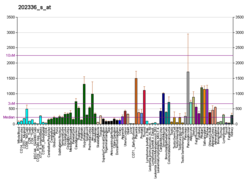PAM (gene)
Peptidyl-glycine alpha-amidating monooxygenase is an enzyme that is required for the biosynthesis of many signaling peptides. This transformation is achieved by conversion of a prohormone to the corresponding amide (C(O)NH2). This enzyme is the only known pathway for generating peptide amides, which renders the peptide more hydrophilic. In humans, PAM is encoded by the PAM gene.
This gene encodes a multifunctional protein. It has two enzymatically active domains with catalytic activities - peptidylglycine alpha-hydroxylating monooxygenase (PHM) and peptidyl-alpha-hydroxyglycine alpha-amidating lyase (PAL). These catalytic domains work sequentially to catalyze neuroendocrine peptides to active alpha-amidated products. Multiple alternatively spliced transcript variants encoding different isoforms have been described for this gene, but some of their full-length sequences are not yet known.
...
Wikipedia




